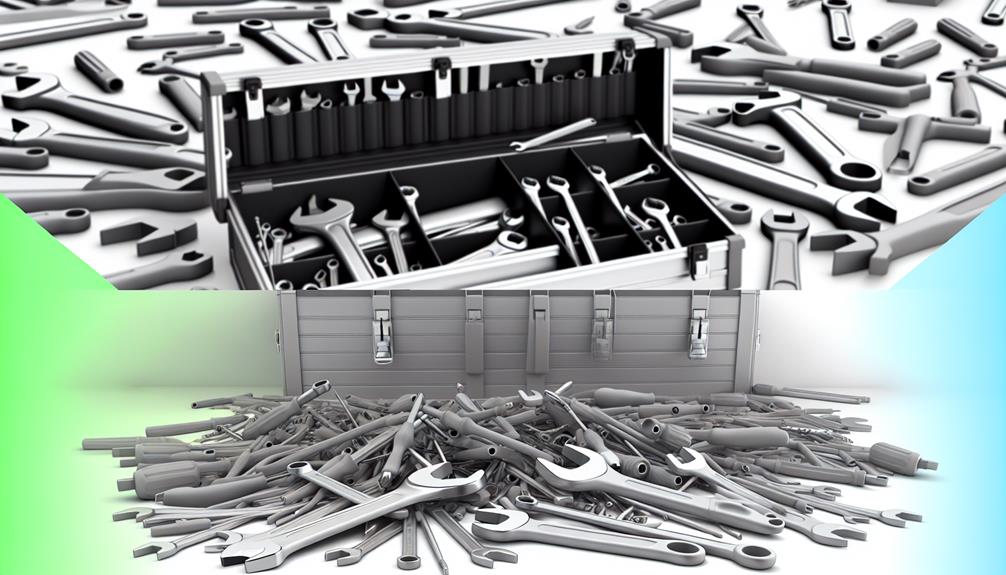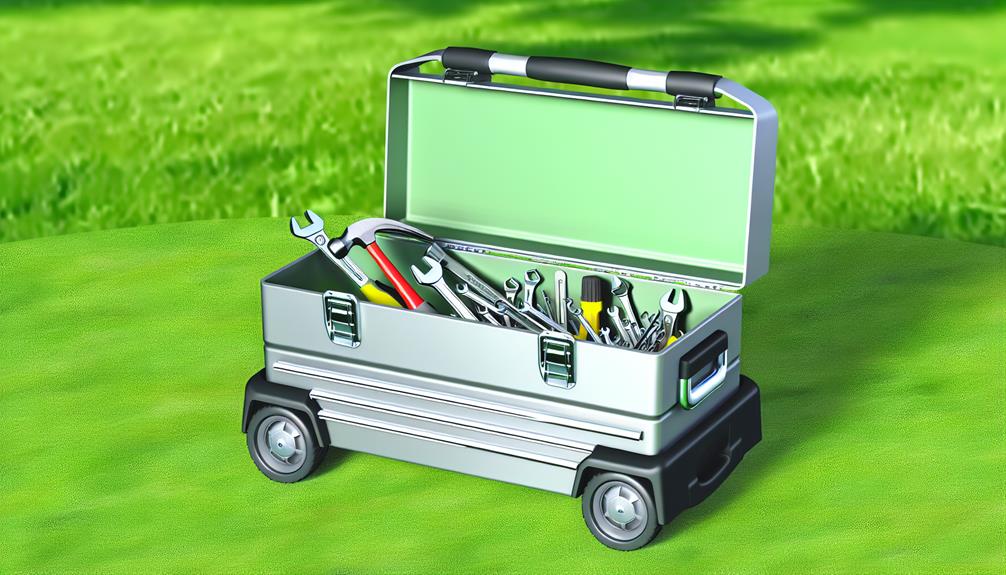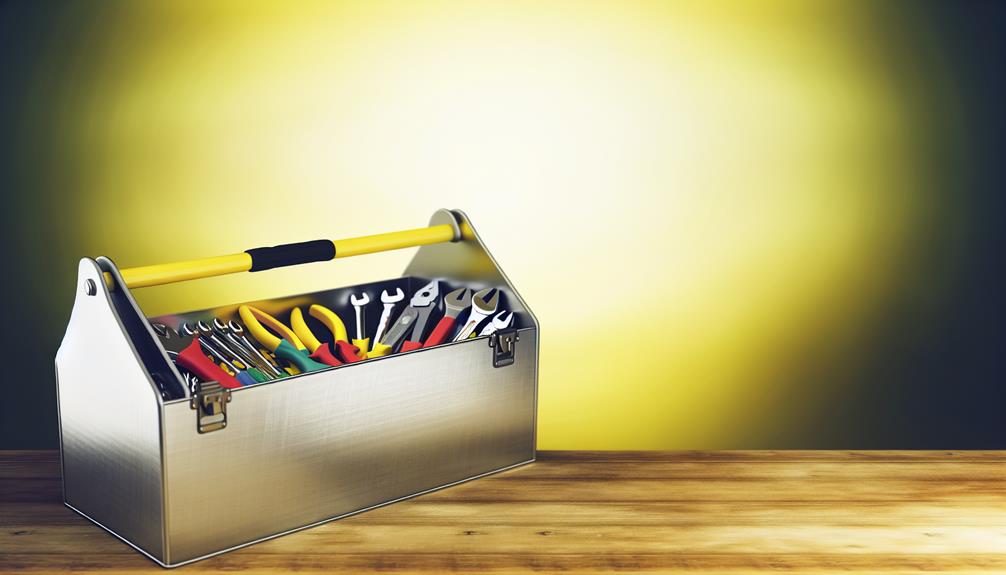Organizing your tools starts with selecting the right metal toolbox. Assess your tool collection first, categorizing items by type and frequency of use. Choose a durable material—steel offers strength, while aluminum provides lightweight portability. Guarantee your toolbox size accommodates your collection with sufficient compartments to keep tools organized. Look for design features like adjustable dividers to prevent loss of smaller parts. Prioritize portability with ergonomic handles and balanced weight distribution. Finally, evaluate the cost against features to guarantee you receive value for your investment. For more insights on maximizing your toolbox's efficiency, further exploration is advisable.
Key Takeaways
- Assess your tool collection size and variety to determine the appropriate toolbox dimensions and organization features needed for storage.
- Choose materials like steel for heavy-duty use or aluminum for lightweight, corrosion-resistant options based on your specific work style.
- Evaluate toolbox design features such as adjustable dividers and removable trays to enhance organization and accessibility for your tools.
- Prioritize portability with ergonomic handles and compact designs to facilitate easy transport and improve workflow efficiency.
- Budget wisely by investing in durable materials and reputable brands, ensuring long-term value and reliability in your toolbox selection.
Assessing Your Tool Collection

When evaluating your tool collection, it is essential to regularly assess both the quantity and variety of tools you possess. This collection assessment is not merely an inventory process; it is a strategic evaluation that guarantees you have the right tool types for your projects and tasks. Start by categorizing your tools into distinct groups such as hand tools, power tools, and specialty tools. This organization allows you to identify gaps in your collection or areas where you may have excess. Additionally, consider exploring local opportunities to discover profitable businesses for sale that might complement your tool collection and interests.
Next, consider the frequency and types of projects you undertake. If you find that certain tool types, such as socket sets or woodworking equipment, are underrepresented, it may be time to invest in additional items. Conversely, assess tools that you rarely use—these may be candidates for sale or donation, thereby streamlining your collection.
Material and Durability Considerations
When selecting a metal toolbox, understanding the various material types is essential to guarantee peak performance and longevity. Factors such as resistance to corrosion and impact are critical, as they contribute to the toolbox's ability to withstand harsh conditions and heavy usage. Additionally, exploring how to protect assets during financial recovery can provide insight into making smart investments in durable tools. Key durability factors, such as resistance to corrosion and impact, play a significant role in maintaining the integrity of the toolbox over time. Additionally, implementing proper maintenance and care practices can greatly extend the lifespan of your chosen toolbox, making it a worthwhile investment.
Material Types Overview
In the domain of metal toolboxes, the choice of material greatly impacts both durability and functionality. Understanding the various toolbox materials available is essential for selecting a model that meets your specific needs. The most common metal types used in toolboxes include steel, aluminum, and stainless steel, each offering unique advantages.
Steel toolboxes are renowned for their strength and resilience, making them ideal for heavy-duty use. They can withstand harsh conditions but may require protective coatings to prevent rust. Aluminum, on the other hand, is favored for its lightweight nature and resistance to corrosion, making it suitable for portable applications. However, while aluminum is less robust than steel, it often compensates with ease of transport and versatility.
Stainless steel combines the best of both worlds, providing exceptional durability and corrosion resistance. This makes it a preferred choice for those in demanding environments or who value aesthetics alongside functionality. When selecting your toolbox, consider how the material aligns with your work style and tool protection needs. By understanding these metal types, you can make an informed choice that enhances your tool organization and longevity.
Durability Factors Explained
The choice of material directly influences the durability of a metal toolbox, making it imperative to evaluate various durability factors when selecting a model. One of the most critical considerations is rust resistance. Materials such as stainless steel or aluminum are often recommended due to their inherent resistance to corrosion, ensuring that your toolbox remains functional and aesthetically pleasing over time.
In addition, look for models that incorporate weatherproof coatings. These coatings protect the toolbox from moisture and environmental elements, greatly extending its lifespan. A toolbox with a high-quality finish not only enhances durability but also minimizes the risk of paint chipping or peeling, which can expose the underlying metal to rust.
When evaluating a toolbox, consider its gauge thickness as well. Thicker, heavier metals are generally more robust and can withstand rough handling, making them suitable for demanding environments. Moreover, examine the welds and joints, as superior craftsmanship will contribute to overall durability.
Maintenance and Care Tips
Regular maintenance is essential to prolonging the life of a metal toolbox and ensuring its durability. To begin with, effective tool cleaning is crucial. After each use, remove any debris, dust, or moisture that may have accumulated. A soft cloth or brush can efficiently eliminate dirt, while a damp cloth can address stubborn grime.
Next, focus on rust prevention, a critical aspect of metal toolbox care. Apply a thin layer of protective oil or rust inhibitor to the exterior surfaces periodically, especially in humid environments. This preventative measure creates a barrier against moisture that can lead to corrosion.
Additionally, inspect the toolbox regularly for any signs of wear or damage, such as scratches or dents. Minor imperfections can be treated promptly with rust-proof paint or sealants to maintain the integrity of the metal.
Size and Storage Capacity

When selecting a metal toolbox, evaluating size and storage capacity is vital for guaranteeing that all tools and equipment can be organized effectively. The first step is to assess your collection of tools, considering various tool sizes and types. This assessment allows you to determine the minimum dimensions required for your toolbox, making certain that it accommodates everything from small hand tools to larger power tools. For those considering a career in fitness, understanding the significance of organization can also translate to efficiency in roles such as fitness sales, where managing equipment is essential fitness sales opportunities.
Next, consider the different storage types available within the toolbox. Some designs feature multiple drawers, compartments, or trays that allow for systematic organization, making it easier to locate specific tools. For instance, a toolbox with adjustable dividers can accommodate varying tool sizes, providing flexibility for future additions to your collection.
Moreover, think about the frequency of use for each tool. High-frequency items should be easily accessible, while rarely used tools can be stored in deeper sections. Finally, make sure that the overall weight and portability of the toolbox align with your needs, particularly if you need to transport your tools regularly. By thoughtfully evaluating size and storage capacity, you can choose a metal toolbox that fosters an efficient and organized workspace.
Design and Organization Features
When selecting a metal toolbox, it is vital to take into account its design and organization features, which greatly impact usability and efficiency. Features such as personal training options can inspire effective organization strategies, as they emphasize the importance of tailored solutions. Storage compartment options, such as removable trays or adjustable dividers, can facilitate better organization of tools and materials. Additionally, evaluating portability and weight factors guarantees that the toolbox can be easily transported without compromising on durability or functionality.
Storage Compartment Options
A well-designed metal toolbox can considerably enhance both the efficiency and organization of your workspace, particularly through its storage compartment options. Effective tool organization begins with thoughtful compartment design that accommodates a variety of tool sizes and types. When selecting a toolbox, consider options with adjustable dividers, which allow you to customize the interior layout to suit your specific needs. This flexibility guarantees that each tool has a designated space, minimizing clutter and facilitating quick access.
Additionally, look for toolboxes featuring multiple compartments and specialized sections for small parts, such as screws, nuts, or nails. These compartments can help prevent loss and damage, contributing to a more streamlined work process. Magnetic strips or pegboard-style backs can further enhance organization by providing easy access to frequently used tools.
Furthermore, consider the depth and accessibility of the compartments. Shallow compartments can be ideal for hand tools, while deeper sections may be necessary for larger power tools. Overall, prioritizing effective storage compartment options will not only foster a sense of belonging in your workspace but also promote a culture of efficiency and productivity.
Portability and Weight Factors
Effective tool organization is only part of the equation; portability and weight factors play a significant role in the overall functionality of a metal toolbox. Selecting the right toolbox styles that cater to your needs hinges on understanding how weight distribution impacts usability, especially when moving from one job site to another.
When considering portability, keep the following points in mind:
- Material: Lightweight metals, such as aluminum, enhance portability without sacrificing durability.
- Design: Choose a toolbox with ergonomic handles for comfortable transport, reducing strain during use.
- Size: Opt for a compact design that balances sufficient storage space with easy handling.
- Weight Distribution: Verify that heavier items are placed at the bottom to maintain stability while carrying.
Portability and Mobility Options

Portability is a crucial factor to take into account when selecting a metal toolbox, as it directly impacts the efficiency and convenience of transporting tools to various job sites. A toolbox that offers a foldable design can greatly enhance mobility, allowing users to reduce its footprint when not in use. This feature is particularly advantageous for those who may need to store their toolbox in confined spaces or transport it in smaller vehicles. Additionally, just as fitness managers at Crunch Fitness emphasize the importance of convenience in managing equipment and resources, choosing a portable toolbox can streamline your own workflow and tool organization key duties of fitness managers.
When considering handle options, it is essential to choose a toolbox with ergonomic handles that provide a comfortable grip. Some models even include retractable handles or wheels, which can facilitate easier movement over longer distances, reducing the strain on your body. Additionally, look for toolboxes with multiple handle configurations, such as side handles for lifting and top handles for carrying, which offer versatility depending on the task at hand.
Incorporating these portability features not only streamlines your workflow but also fosters a sense of belonging to a community of professionals who value efficiency and practicality in their tool organization. Ultimately, selecting the right mobility options can improve your overall productivity and satisfaction in your work environment.
Budget and Value for Money
When evaluating options for a metal toolbox, understanding your budget and guaranteeing value for money is essential for making a wise investment. A well-chosen toolbox not only serves its purpose but also enhances your overall organizational experience. To achieve this, consider the following factors during your cost comparison:
- Material Quality: Invest in durable materials that guarantee longevity and withstand wear and tear.
- Size and Capacity: Select a toolbox that meets your storage needs without excess bulk, which could lead to unnecessary costs.
- Brand Reputation: Research brands known for their reliability and customer service; this can often lead to better value in the long run.
- Warranty and Support: Look for products that offer warranties, as they can provide assurance of quality and potential cost savings over time.
Frequently Asked Questions
Can I Customize My Metal Toolbox With Personal Designs or Colors?
Yes, you can customize your metal toolbox with custom designs and various color options. Many manufacturers offer personalization services, allowing you to select unique patterns or graphics that reflect your personal style. Additionally, you may choose from a range of colors to guarantee your toolbox aligns with your aesthetic preferences. This not only enhances the visual appeal but also fosters a sense of belonging and ownership over your tools, making them distinctly yours.
How Do I Maintain and Clean My Metal Toolbox Effectively?
Maintaining and cleaning your metal toolbox is essential for longevity and functionality. Begin by regularly removing all tools and debris, followed by wiping surfaces with a damp cloth and mild detergent. For toolbox rust prevention, apply a rust-inhibiting spray to exposed metal areas. Additionally, consider implementing toolbox organization tips, such as using dividers or trays, to enhance accessibility and prevent clutter. Regular maintenance not only preserves appearance but also guarantees efficiency in your tool management.
What Are the Best Brands for Metal Toolboxes?
When evaluating the best brands for metal toolboxes, brand comparison reveals several industry leaders. Notable names include Craftsman, Husky, and DEWALT, each offering distinct toolbox features tailored to various needs. Craftsman is renowned for durability and organization, while Husky emphasizes affordability with robust designs. DEWALT, on the other hand, provides advanced options for professionals. Selecting the right brand ultimately depends on individual preferences, intended use, and desired toolbox features that enhance functionality and efficiency.
Are There Any Eco-Friendly Metal Toolbox Options Available?
Yes, there are eco-friendly metal toolbox options available in the market. Many manufacturers are increasingly utilizing sustainable materials, such as recycled aluminum and steel, which not only reduce environmental impact but also enhance durability. Additionally, some brands offer recycling options for their products, ensuring that end-of-life toolboxes can be repurposed. When selecting a toolbox, consider these sustainable features to contribute positively to the environment while maintaining a professional standard in your tool organization.
Can I Use a Metal Toolbox for Non-Tool Items?
Yes, a metal toolbox can effectively serve as a storage solution for non-tool items. Its durable construction and compartmentalized design make it suitable for organizing various household or office items, such as craft supplies, stationery, or even kitchen utensils. By repurposing a metal toolbox, you can create alternative uses that enhance organization and accessibility. This approach not only maximizes utility but also fosters a sense of belonging through personalized storage solutions tailored to your specific needs.

